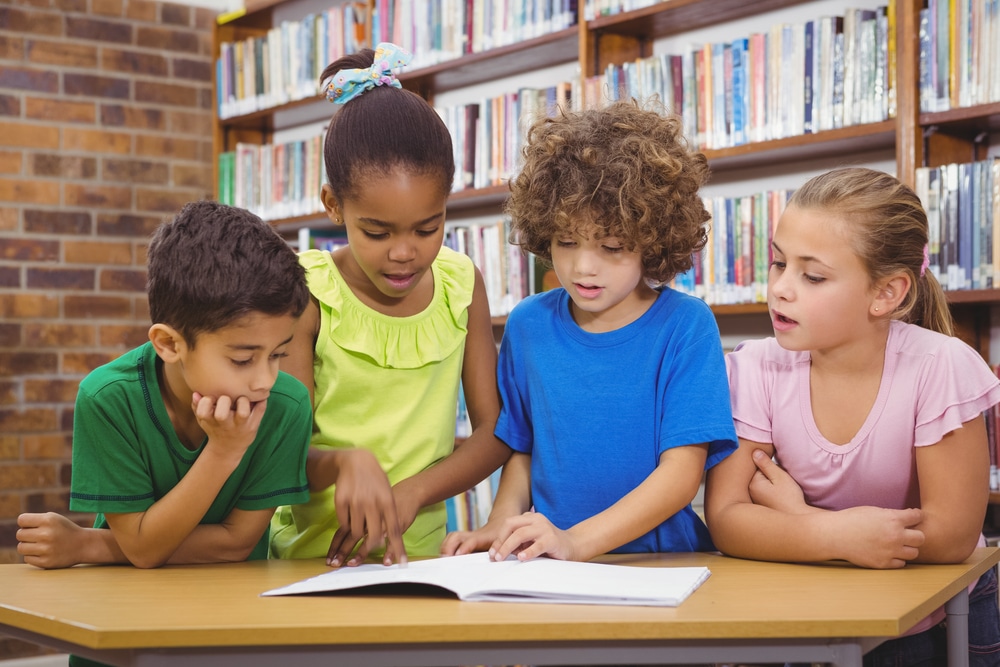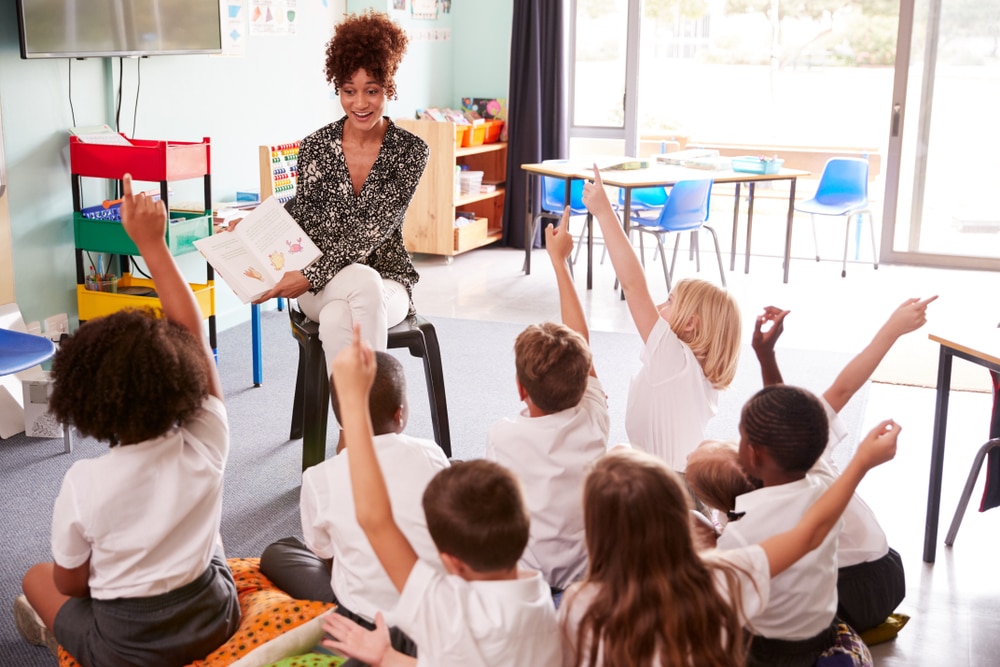Teach guided reading in the classroom
Guided reading in the classroom is crucial for children’s education as it develops key English skills such as reading and comprehension. It is important for teachers to fit guided reading into their lesson plan every day in small 30-minute chunks. However, we understand that it can be quite difficult to implement guided reading and to know how to make it beneficial to pupils.
We explore what guided reading is and the key benefits as well as carrying guided reading out in lessons. Plus, take inspiration from our guided reading activities that can help all reading abilities.
What is guided reading?
Guided reading involves small groups designed to provide different teaching techniques to pupils. Children work in groups with similar reading capabilities and ages. Doing this assists in developing reading proficiency as well as teaching crucial reading skills.
With a smaller group, guided reading can be done in a way that’s focused on children’s specific needs which helps to progress them in their reading skills.
Purpose of guided reading
The purpose of guided reading is for pupils to problem solve and practice various English skills. This can be done by using texts that are at the appropriate reading level for pupils. Teachers set texts that are within the groups reading capabilities and children must read this individually. In turn this gives pupils a chance to develop the skills they already have to new texts which continues to develop their reading skills.
Guided reading helps pupils develop greater control over the reading process through various skills they learn. It assists with decoding and constructs meaning from the text. Teachers guide children as they read, talk, and think through the text and find the meaning.
Benefits of guided reading
There are multiple benefits of guided reading for children. It is the most effective tool not only to improve fundamental reading skills but to help develop a higher reading comprehension. Guided reading aims to improve these skills for both good and struggling readers. Also, it identifies weaknesses and strengths in children’s abilities so they know what they can do and what they need to work on.
Guided reading is great at improving children’s attention to detail skills as they must focus on small details to achieve learning outcomes. It is perfect for building fluency in reading and expanding their vocabulary.
Through the questions and answers system that occurs with guided reading, pupils build confidence skills. They can ask questions freely in dedicated question time or whilst the teacher is discussing the text with the class. This assists with improving the understanding of texts. Another way in which guided reading is beneficial is it helps to improve targeted word work and sight word practice too.
Implementing guided reading in the classroom
It can be difficult to find time within the school day to slot guided reading in. However, it is imperative that teachers find time every day. Often, guided reading can seem like a long process, but it should only be in small bite sized chunks.
We have provided teachers with some useful information on how to implement guided reading in the classroom.
Dedicate 30 minutes every day
Guided reading enables children to develop their key English skills so must be implemented every day. However, due to working on it every day, dedicate a small time frame (30 minutes should be enough). This will ensure children learn to discuss texts and analyse them properly as it becomes routine. Use our guided reading packs to assist these 30-minute daily sessions so children can read plenty of different texts.
Provide extra reading support
A benefit of guided reading for teachers is that it can help identify who is struggling with reading. This can help teachers put a plan in place to provide extra reading support to those pupils who are struggling. This can be more one-on-one reading time with yourself, a teaching assistant or even a more enabled pupil. This will assist struggling pupils as they grasp texts through the support.
Using a pupil to assist is a huge help for struggling children as they can have texts broken down to them in a way they understand. This is due to having someone of similar age explain to them and simplifying in a way teachers find hard to do.
Decoding and Comprehension
Think about decoding and comprehension for guided reading sessions. Each day see how you can improve the class’s decoding and comprehension skills.
Decoding is simply turning a written word into a spoken word, regardless if the word has been understood. Teachers can teach children how to decode by encouraging them to split a word up and sound it out. They can understand what sounds each word uses which builds phonics skills too. Try using images as well to further assist with this. Another strategy is to say the whole sentence out loud but leave out the word a child is struggling with. Ask what the word could be to finish the sentence off. The child can then base the word on what is included in the sentence.
Decoding will then help with comprehension as this is understanding what has been read. From this, children will be able to write and talk about texts.

Analyse texts
A part of guided reading is analysing texts. This can be done in a simplified way depending on the age range of the class. Whatever the class’s age range is, make sure to analyse texts in detail. Whilst doing this, check that every child can read and understand each word and can discuss the meaning of the text. This can be done in any way but is usually easier to discuss as a class and lead the discussion with questions that aim towards learning outcomes and the meaning of the text.
Have an activity carousel
During guided reading sessions, have an activity carousel in the classroom. Split the class into small groups so they can move around the classroom to do different activities. Guided reading will be one option with the teacher, so every child gets some time to do this as well as other key activities. Include challenge cards as part of the activities to make guided reading fun whilst you’re with the focus group.
Before reading
To prepare pupils for the session, teachers can discuss their prior knowledge of the text, particularly if it is a longer text that is set for the week. Start to encourage children to predict what happens in the rest of the text and summarise the plot for them so they have a basic understanding. Whilst doing this summary, point out the most important parts of the text that helps to achieve the set learning outcomes. This could be where the meaning of the text is and clarifying it.
Introduce any new vocabulary that is used and show them the relevant text layout such as: punctuation, headings, pictures, index and glossary. After this, point out the learning outcomes of this session and discuss the purpose of the text so that children can focus on these.
During reading
During the reading session, teachers must listen to individual pupils and observe their behaviours for evidence of achieving the learning outcomes. Be on hand to assist with problem-solving as they discuss the text especially if the text is at a higher level. This will progress the class to understand complex texts. When pupils are problem-solving individually, notice their attempts and success. Make sure to give them specific feedback that they can work on to improve.
Throughout the session make notes about strategies the children are using and questions or struggles that flag up. This will help with future planning and pupil goal setting.
After reading
After the reading session, dedicate time to questions pupils may have. Note down the common questions so that you can tackle this problem area. Talk about the text with the class too and welcome personal responses such as pupils making connections themselves. Make sure to return to the text to identify a decoding teaching opportunity. Guide this talk with our reading comprehension cubes using the dice of questions for pupils to answer.
Discuss insights in characters, setting, and plot to solidify their understanding. To further assist with this try retelling the story in a summarised way. You can also develop understanding of the authors intent and conflicting interpretations of the text.
At the very end of the session, revisit the learning outcomes and allow the class to reflect on if they have achieved them.
Guided reading activities to do
There are plenty of guided reading activities teachers can do with their class to develop reading proficiency. Below we list a few fun and unique activities that you can try out with your class!
Character interview-
Channel morning TV presenters and write an interview script between an interviewer and a character from the book. Children are likely to come up with a lot of ideas for questions, but they may struggle more on the answers. Consider modelling a couple of answers before you send children off independently.
Letter to the author-
Why not get the children to write a letter to the author of the book they are reading? The bonus to this is that you could genuinely send the letters and see if you get a response.
Sell a holiday to the setting-
Give children a selection of holiday brochures as models; you can often find digital versions on holiday sites to avoid unnecessary printing. Then ask the children to write a paragraph about a setting from the book selling it to potential tourists.Stretch! A great way to stretch children is to create parodies of text types. Choose a setting that is unpleasant and get children to sell that place to tourists.
Continue the story –
Challenge children to write the beginning of a sequel to the book they have just completed. You might introduce children to fan fiction that often arises off the back of a well-loved book and discuss the merits of such fiction.
Social media profile for a character –
Social media profiles reveal a lot more about a person than just their name. What might they update their status to? What pictures might they post? What would other characters comment on the pictures? This is also a great opportunity to discuss social media vs reality.
Chart the feelings of a character –
Draw out a basic graph with chapter numbers along the bottom and a scale of emotions on the left. Get children to plot the change in emotions throughout the book. They can look back on what is likely to be a rollercoaster of emotions and label events along the graph.
Dear Agony Aunt –
Get children to write an Agony Aunt response to a problem a character is facing in the story.
For more fun guided reading activities check out our 29 guided reading activities
Guided reading in the classroom needs to be thoughtfully planned out and executed every day children to develop vital reading proficiency skills. Implement these strategies into you to develop key English skills that children need to gain higher comprehension levels. Remember to make sure everyone fully understands the text in these sessions and provide additional support to those pupils who are struggling.






